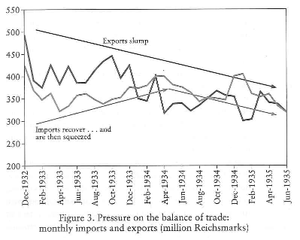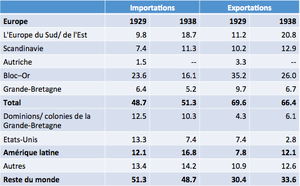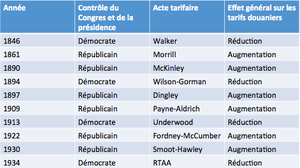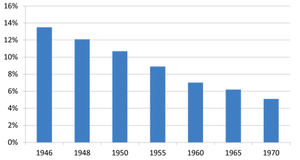Divided trade policies: 1946 - 1973
| Professeur(s) | Mary O'Sullivan[1][2][3] |
|---|---|
| Cours | International Economic History |
Lectures
- Introductory aspects of the International Economic History Course
- Introduction to the International Economic History Course
- Between Free Trade and Protectionism: 1846 - 1914
- International triumph of the gold standard: 1871 - 1914
- International Finance and Investment: 1860 - 1914
- New Challenges in International Trade: 1914 - 1929
- New monetary and financial order: 1914 - 1929
- Dark history for the world economy: 1930 - 1945
- Crises and regulations: 1930 - 1945
- Divided trade policies: 1946 - 1973
- Bretton Woods System: 1944 - 1973
- Money, Finance and the World Economy: 1974 - 2000
- Trade and the World Economy: 1974 - 2000
The international trade upheaval of the 1930s[modifier | modifier le wikicode]
The Great Depression is a real crisis of the international economy. During the 1930s, international trade recovered only slowly. The level of international trade in 1938 remains below its 1929 level.
Between 1929 and 1938, the importance of international trade fell. To understand the most important developments in international trade during the 1930s, one cannot only focus on trade volumes, but also on the structure of international trade. There is a tendency to conclude bilateral or regional agreements being constituted in different ways with different models.
On the one hand, there is a Soviet or German model seeking to expand the area of influence under a country's control in order to make it more independent of the world economy. It is a restructuring of international trade within the framework of autarky.
Since the end of the 19th century, Germany has been an economy highly dependent on international trade, highly dependent on imports and food imports, which have increased as a result of the country's industrialisation, but also on raw materials such as raw cotton and raw iron, but also on oil, which is increasingly replacing coal, especially with the growing importance of the automobile and airplane. It is a country heavily dependent on imports to support the economy. It is a country that relies heavily on exports to pay for its imports. There is also the burden of reparations and foreign debt to pay. The Great Depression created an external situation for Germany that was catastrophic.
We see the drop in German exports highlighting that the country is struggling to pay for the imports it needs.
We see the consequences of these problems on the balance of goods, the gold and currency reserves of the German central bank. Around 1934, the situation was catastrophic. There is a demonstration by the international community, in particular through international agreements, to relieve Germany of its financial burden. The Hoover moratorium puts a temporary end to the payment of repairs. In 1931, an agreement to stop Germany's short-term debt was signed by Germany's creditors.
Il y a une volonté de la part des créditeurs d’aider l’Allemagne à survivre économiquement. Il y a une négociation autour de cette dette et des accords signés avec notamment la Suisse, les Pays-Bas ainsi que les États-Unis et la Grande-Bretagne. Toutefois, il reste le problème des dettes commerciales à long terme.
With the desperate situation of long-term debts and gold stocks, Germany risks defaulting in the long term. Germany will take the decision on June 8, 1933 to repudiate the debts raising protests. But it will back down following threats from trading partners to block or seize German export revenues to pay German debts. It is a weak point in the German economy that depends on its own revenues to pay for its imports, creating tensions with trading partners. German weakness had an important influence on Hitler and the Nazis forced to play the game in the short term with an effort to negotiate with creditors to ease the situation. There is also a reduction in imports of non-essential goods. There are multiple reactions to this external problem, but there is the beginning of a medium-term clarification to escape a longer-term situation. Germany decides to reduce its dependence on powerful trading partners and especially Great Britain and the United States. This is a situation taken in the face of German vulnerability and its external position. First, there is the effort to achieve self-sufficiency from an agricultural and industrial point of view with the creation of synthetic products to replace, for example, rubber and oil. In 1932, Germany signed agreements with Central European countries supplying primary materials to Germany and purchasing manufactured goods from Germany.
We can see the consequences of this strategy in relation to Central and Eastern Europe. The proportion of Germany's trade with Central Europe is increasing as part of a German-controlled zone of influence. Germany seeks to incorporate Latin American countries including Brazil into its zone of influence by incorporating them into its trade. However, this region of Latin America keeps important relations with the United States, but also Britain.
There is a sharp increase in the importance of Latin America as a market for German products, but also as a source of supply. We see a significant reduction in Germany vis-à-vis Great Britain and the United States. Germany has been successful in reducing its vulnerability. We see similar events for the Soviet Union, Italy and Japan. There is a growing trend towards self-sufficiency in a more general sense. The autarkic model in particular is associated with a certain type of political system and regime.
A model is developed by Great Britain in particular and France too. With the British case, which has been the bastion of free trade since 1846, its strategy changed in the 1930s. Faced with the Great Depression, Great Britain broke with free trade history by introducing customs tariffs in the early 1930s. A preference was established with Commonwealth countries following the 1932 Ottawa Accords. The Commonwealth is titled the Imperial preference within the framework of an association between autonomous, freely associated and equal countries in membership of a common allegiance to the British Crown. Trade agreements were signed in 1932 establishing imperial preference within the Commonwealth. This corresponds to a lower tariff regime for member countries and an increase in trade duties to or from non-member countries. It's club logic.
There has been a dramatic increase in trade under regional agreements. France is also setting up an imperial preference system which it is pursuing to create protected zones in which protectionism is limited, but protecting itself against external countries through customs tariffs. The French Empire provided 29% of imports in 1936 against 11% in 1925.
A major shift in U.S. trade policy[modifier | modifier le wikicode]
With the United States, we talk about the hegemon of the world. The United States has long been a typical example of protectionism, being a highly protectionist country since the Civil War and even before with a policy of high tariffs, though not necessarily unanimously accepted.
The two main political parties do not agree on protectionism. The Democratic Party is less protectionist and free trade than the Republicans. The fact that the United States pursues a protectionist policy most of the time is explained by the dominance of the Republican Party.
When we talk about the Smoot-Halley Act, he fully agrees with the dominant trend. It is only when the Democrats are in power that tariffs are reduced. Given that the Democrats won the 1932 elections, a reduction in tariffs was expected, but the context being very difficult to make such a decision, this created an obstacle to such a decision. Unemployment is very high, tariffs are rising elsewhere and there is therefore opposition to tariff cuts. President Franklin Roosevelt is ambiguous on the issue of protectionism and lowering tariffs. The Democrats are abandoning the idea of lowering customs tariffs. Yet they continued to reduce tariffs with the Reciprocal Tariff Act[RTAA] of 1934. Democrats are pursuing greater autonomy for the president by negotiating a reduction in bilateral tariffs. It frees the American president from the oversight of Congress where protectionist pressures are strong and difficult to control.
In 1934, we see an important turning point in the commercial policy of the United States which will carry out a policy of reduction of the protection negotiating 22 agreements between 1934 and 1940 reducing the customs duties and the quotas.
The fall reflects only the negotiated decline, but it is more a combination of deflation and the fact that tariffs are negotiated in nominal terms. Even if in the short term, one should not underestimate the importance of the institutional change of the RTAA, in the medium and long term, the American president's freedom in the field of trade policy has important consequences because it is the president's ability to engage the country in a new international order after the Second World War that is not possible with the old system.
International Trade and the Second World War[modifier | modifier le wikicode]
The combatants do their best to blockade the international trade of their enemies. The fighters rely on the submarines. At the height of the maritime conflict in 1942, 1500 merchant ships were torpedoed in the Atlantic. The dangers of marine transportation are evident in the rising prices of marine insurance premiums. For a trip to Calcutta, it rises to 2% of the value of transport goods in 1941 to 10% during 1942 and to 30% in August 1942.
Despite all their efforts to restructure international trade, we see that the Axis countries remain vulnerable being far from having solved the problem of basic supplies to feed the net population continue the war.
We see the imports from Germany and the consequences of the war for Germany. Japan which also from the outside necessary for the production of arms. There is a significant vulnerability that remains for the Axis countries. The Axis bloc is very effective. Germany will favour trade relations with the countries of Latin America, which however becomes almost impossible in this war context.
To counter the allied blockade, new strategies were put in place, notably with the German-Soviet pact in 1939 concerning the delivery of food and oil, but in 1940 it was looting and exploitation of occupied countries. With France, Germany has at its disposal a country almost as industrialized as its economy. The decision to move forward with Operation Barbarossa is partly explained by the desire to expand Germany's sources of supply. Hitler launched Operation Barbarossa on 22 June 1942. The conquest of a space in the east is created with the objective of supplying German politics and economy on the basis of an integrated space.
The same can be said for Japan, which seizes coal and cotton in China, rubber in Malaysia and Ceylon, and dioxide in the Dutch Indies. There is a growing dependence on the region it controls. Cooperation between the Axis countries is becoming almost impossible. The United States exports mineral and industrial products to help Britain and the Soviet Union. Without the support of the United States, it would not have been possible for Britain and the Soviets to continue the war.
The international trade of Great Britain, France and the countries at the heart of the conflict declined sharply while exports from the United States increased by 3 times compared to their pre-war level. Following the Second World War, we see a hegemon with power over the world economy as never seen before. The United States overtakes Britain as the hegemon being the big winner of World War II, its losses are negligible, its investments are significant leading to an increase in investment and GDP representing 50% of world GDP.
For Great Britain, the Second World War ended Britain's claims to world domination because Britain emerged economically weakened from the war, but political changes also announced the end of its empire with the independence of India and Pakistan in 1947 and Burma and Ceylon in 1948. Following the war, we do not see Britain ceding its empire, but a willingness to integrate these colonies in a different way. Despite the intentions of the elite, the Suez crisis of 1956 ended Britain's imperialist illusions. There is a clear trend towards decolonisation and the collapse of European empires. Alongside the economic and military dependence on the United States, the European powers are confronted with their hemogenic and territorial decline. States are confronted with their borders of origin.
The inspirations to independence date back longer, but the end of the Second World War highlights the weaknesses of traditional empires and colonized populations raise questions about the future of traditional empires. Between 1945 and 1965, empires were dismantled with the exception of Portugal. The empires do not accept the loss of their colonies and France is perhaps the longest to accept the unacceptable coming out of the war with the shame of Vichy, refocusing on its empire to try to keep the territories considered particularly important by the French.
Trade policies divided in the post-war period[modifier | modifier le wikicode]
The role of Europeans is diminishing in terms of economic and political power, but there is also the emergence of autonomous countries that have the capacity to know what to do in terms of trade policy. Post-war trade policies are divided. There is no doubt that international trade is increasing strongly in this period of history. The largest increase is in international trade in manufactured goods.
In 1970, the level of globalization of international trade competed with that of the First Globalization. At the end of the war, there was a desire to create a remnant with the Havana Charter, which in 1948 provided for the creation of the International Trade Organization[ITO], which was to represent a pillar of the world economy with the IMF and the WTO. The ICO's idea is to extend the system of bilateral agreements between trading partners worldwide in order to negotiate tariff reductions at a global level. Pending the necessary ratifications at the ICO, the first general agreement on customs tariffs negotiated in Geneva in 1947, the GATT, came into being. The party countries begin negotiating tariff reductions pending the creation of an organization to manage them. The Havana Charter never comes into force because it is not ratified by the United States Congress making it impossible to have an international trade organization. On the other hand, unilateral efforts are focused on the GATT. It was only in 1994 that the WTO replaced the GATT as the framework for organizing international trade.
The reluctance of the United States to ratify the ICO shows that despite the almost total dominance of the United States in the post-war period, there is no talk of a country fully convinced of the benefits of free trade. The dominant ideology and especially that of the Republicans has changed a lot since the 1920s with a greater influence of the interests especially of multinational companies like Ford, Coca-Cola who are big sellers on world markets. It is not only the shareholders and managers of these companies who are in favour of free trade, but also the main trade unions such as the CIO or the United Auto Workers. Yet agricultural interests show a strong reluctance to free trade as well as isolationists like Senator McCarthy.
We see internal conflicts in the American policy that agrees with the ambivalent attitude of this hegemon about trade policy. This ambivalent attitude explains the refusal to ratify the ICO, but also a period of great enthusiasm for free trade immediately after the war.
Even for manufactured goods, there is no reduction in customs tariffs and there is even a slight increase. Tariff progress in the post-war period is recorded for manufactured goods, which continues to pose a problem to this day because the agricultural sector is treated differently.
At the end of the war, the British demanded a reduction in American tariffs while justifying keeping the imperial preference by the situation they faced after the war. In the 1950s, Americans became increasingly impatient with Europeans and British. There is a risk of deadlock in terms of multilateral negotiations and the trend towards free trade is risky. With the Treaty of Rome in 1957, the six founding members decided to create a common market. It is this development that pushes the United States to lower its tariffs to promote freer international trade.
In the early 1970s, the Atlantic acquis was impressive. There is an increase in international trade relative to economic activity. Europeans are taking advantage of the agricultural treaty to do the same. We cannot talk about a free trade area in agriculture for rich countries. When we talk about the post-war free trade regime, we are talking about manufactured goods.
« To say that the immediate postwar years were ones of growing liberalization... is to adopt a perspective that ignores the experience of the vast majority of mankind. »
— Findlay & O'Rourke, 2007, p. 489
Even if we can see an integration of the Atlantic economy, it does not concern the world economy. To speak of globalization in the post-war period is to neglect certain countries of the world. There are exceptions. We do not have very reliable data for most developing countries.
During the First Globalization, Argentina was an open country dependent on imports. In 1973, the situation was quite different. In the case of Brazil, there is stability and even a slight increase. These exceptions pursue clean development strategies. There are several explanations for these trends that vary from country to country.
Communism and the Cold War mean that there is often a reduction in international trade that existed before, exchanges between communist countries replace international exchanges that do not necessarily increase the level of activity in terms of international trade. Decolonization means that the old international exchanges between mother countries and colonies are often broken, not necessarily seeing the continuity of exchanges. Other examples after the Second World War show a change between colony and mother country following the decolonization process. Development policies reinforce this trend by substituting imports by domestic manufacturing for the economy. This development policy is very widespread in Latin America.
So clearly there is liberalisation, it does not concern Latin America as a country like Germany. Agricultural policy in rich countries is a special case where protectionism persists, because agriculture is a privileged sector in terms of controlling food supply in order to insist on a country's sovereignty.
« There was one region of the world... which held aloof from the general drift towards protectionism: the northern Atlantic economies of Western Europe and North America, under the military & political leadership of the United States. »
— Findlay & O'Rourke, 2007, p. 489















